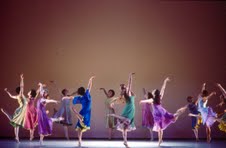Mark Morris Dance Group combines poems of John Milton with art of William Blake in 'L'Allegro, il Penseroso ed il Moderato'

Courtesy of Ken Friedman
By Laura Rivera
May 6, 2011 7:42 p.m.
Mark Morris Dance Group
Music Center’s Dorothy Chandler Pavilion
Four performances, May 5-8, 2011
![]()
![]()
![]()
![]()
The voice of John Milton and the vivid watercolors of William Blake come alive in the performance of “L’Allegro, il Penseroso ed il Moderato” by the Mark Morris Dance Group.
In the first collaboration between the Music Center and LA Opera, Mark Morris’ choreography and vision united the LA Opera Orchestra and Chorus with George Frideric Handel’s pastoral odes and Milton’s poetry in the voice of singers Hei-Kyung Hong, Sarah Coburn, Barry Banks and John Relyea. Set colors and costumes inspired by Blake’s flowing watercolors splashed alive in the movements of the dancers, like colors on a canvas.
Told in two parts, Milton’s poems serve as a script for the dancer’s movement as they play out impressionistic or figurative interpretations of his words. The dancers move to form trees and shrubs in a scene in the woods and playfully chase one another in a figurative representation of a hunt. In another, bodies huddle to form a fireplace and hands flicker and shake loosely to represent fire.
The dancers perform a gorgeous metamorphosis from shapes to natural objects like leaves, and their movements gracefully interconnect in a sort of mandala sequence formation. Their interpretations are earthly and pastoral, and the soft and subtle motions, like the slight twitch of a head or the flick of a loose wrist, call to the organic harmony and disorder that exists in nature.
The poem itself is divided in two modes. “L’Allegro” rejoices in the pleasures of life, and “Il Penseroso” delights in the melancholies. The dancers set their bodies to both moods, thrusting their arms up like a war cry as the singers chant for melancholy, and at another the dancers roll their bodies on the floor with laughter and mirth. The dance’s gestural divisions, however, were not as stark as the poem itself and sometimes required a slight look at the poem handout to remember what tone they are in.
Although the subjects are academic, there is no need to know Milton’s work to truly delight in the beautiful gestures of the dancers. In the mode of “L’Allegro,” silly and playful dancers topple to the floor in a drunken stupor or prance and contort their bodies like a fox. It allows for there to be a real bodily engagement with the dance besides a critical analysis of its concepts.
The exquisite set design by Adrianne Lobel and the lights occasionally shift from dreamlike to daylight through changes in the color scheme and a foggy filter between the background and foreground. The set is lyrical and sensuous, casting the tone for the dancers.
With the undulation of their arms, the dancers bid the audience to come hither. In Milton’s voice, “These delights if thou canst give, Mirth, with thee we mean to live,” the calling dancers invite the audience to delight in mirth with them. The performance was delightful, playful and lyrical. The mingling of artworks from different periods seemed to flow naturally, connected by a conceptual similarity and the expression of human pleasure in both mirth and melancholy.


